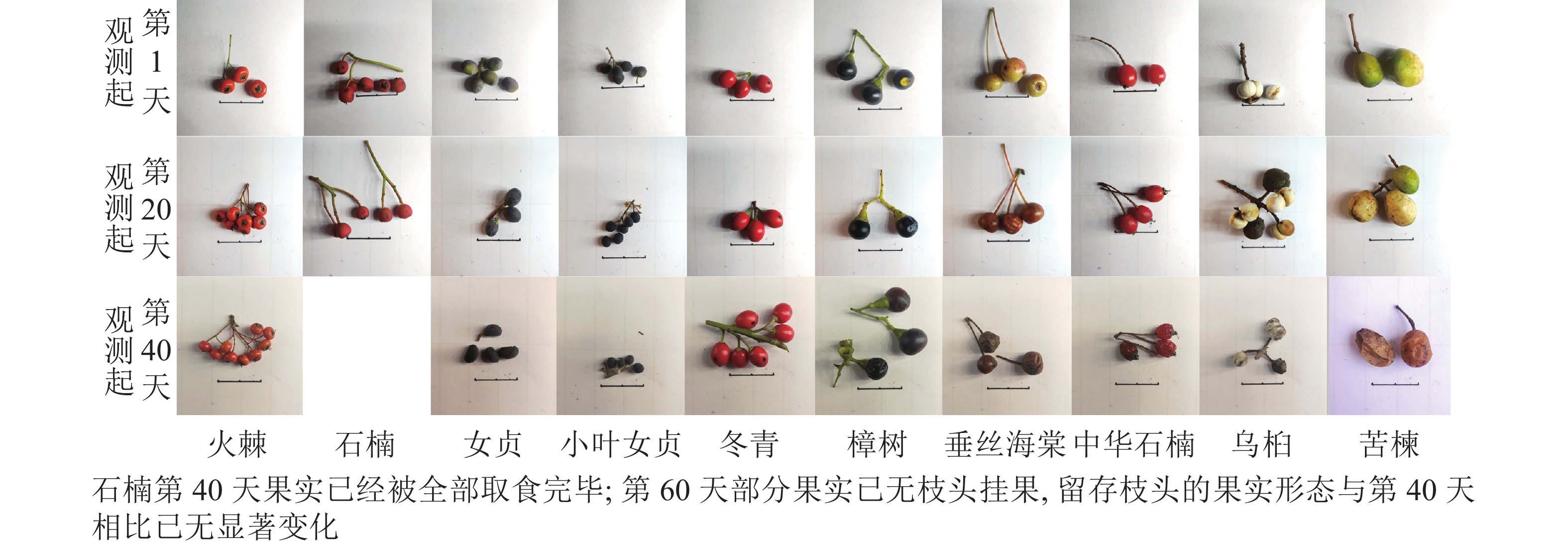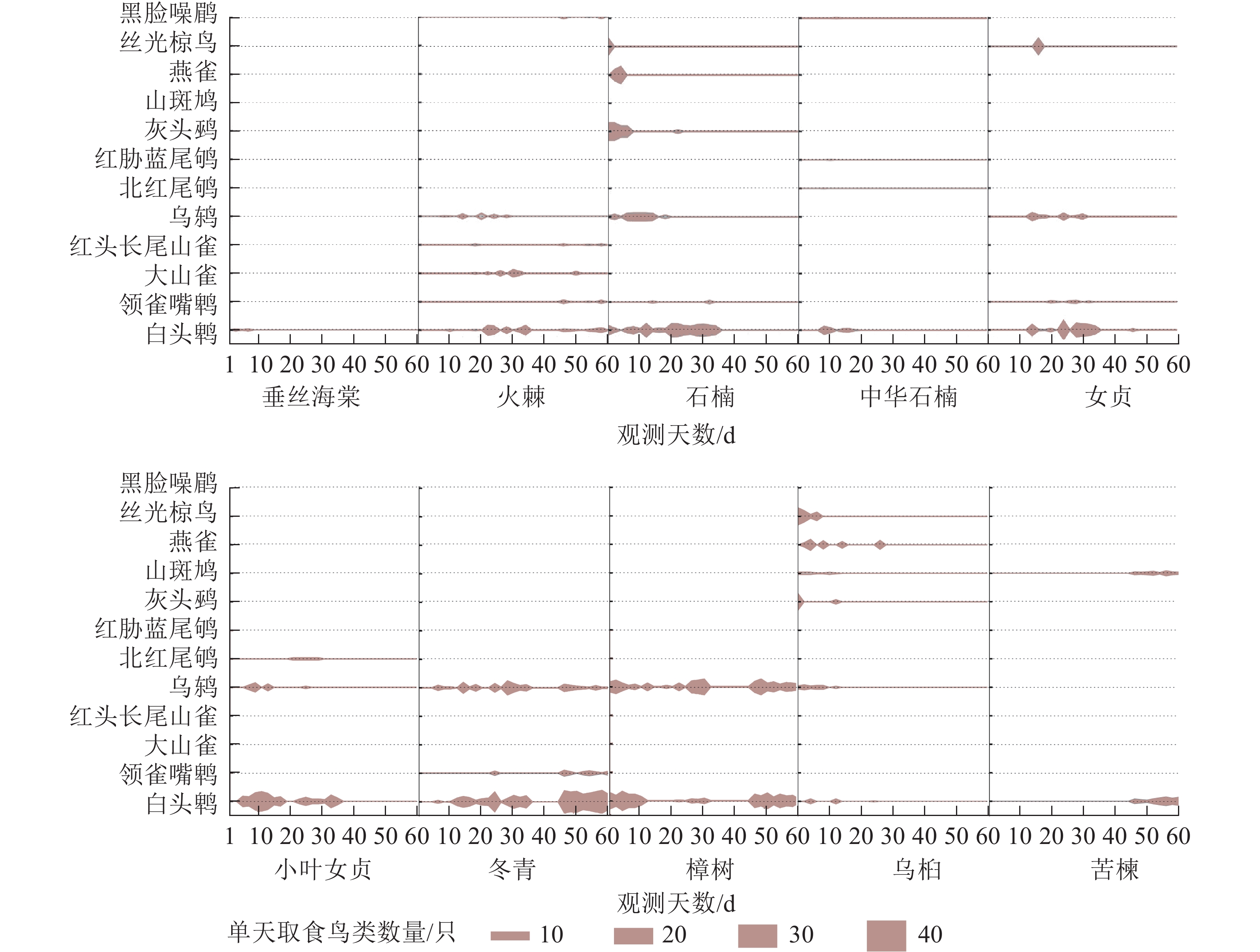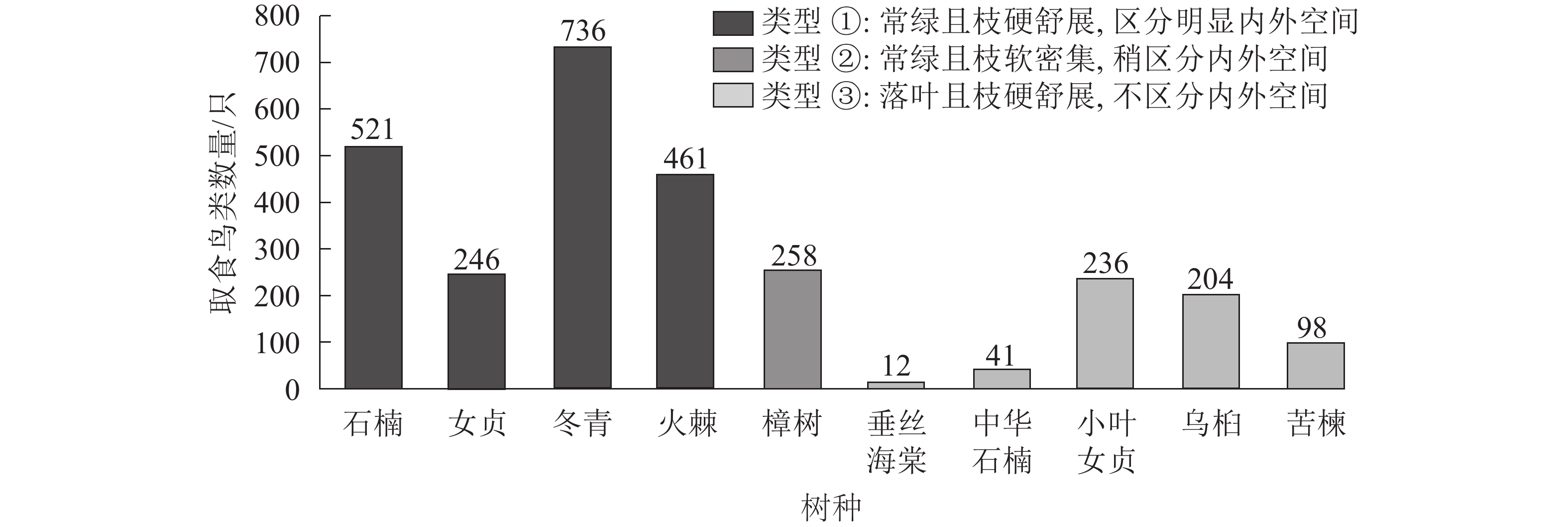-
生物多样性是人类赖以生存的重要支撑,对城市的可持续发展具有重要意义[1]。鸟类是城市中最为常见且易于接近的动物,有利于促进城市居民身心健康[2]。但是,在城市化等剧烈人类活动干扰下,鸟类赖以生存的栖息地不断减少,鸟类生物多样性急剧下降,引起了国内外学者的广泛关注[3]。长江三角洲城市群是中国经济发展最快的地区,城市化水平高,鸟类栖息地破碎化严重,研究该地区鸟类栖息环境营建的理论和方法具有重要的实践应用价值。城市鸟类主要食物来自植物[4],园林植物的果实是城市鸟类植物性食物的主要组成部分[5],合理配置挂果树种对吸引更多鸟类具有重要意义。同时由于食物的可获得性直接影响鸟类对生境的选择[6],因此对鸟类取食与食源树种果实特性关系的分析是研究城市鸟类栖息环境构建的重要基础之一。目前涉及鸟类取食与果实特性关系的研究可归纳为果实所处植物空间、果实外特性和果实内特性3个方面:果实所处空间的高度特征对鸟类取食有明显影响[7],鸟类取食时其形态特征与果实生态特征存在一定对应性[8-9],鸟类对不同果实类型的取食(如肉质核果、梨果等)存在一定偏好 [10],同时受进化演替的影响,果实颜色、大小与鸟类取食存在相关性[11-13],鸟类更倾向于高糖分、低蛋白的果实,并且不同鸟类对果实脂肪含量的选择倾向存在差异[14-15]。长江三角洲地区进入秋冬季后鸟类食源整体减少,但鸟类数量却有所增加,这使得植物果实供给压力增大。因此,本研究以杭州市临安区绿地中常见的秋冬季鸟类食源树种为研究对象,分析果实特性中的果实所处植物空间、果实形态变化、果实内含物与鸟类取食之间的关系,为长江三角洲地区城市生物多样性规划和引鸟植物景观营建提供理论支撑。
-
本研究在浙江农林大学东湖校区内开展。该校区位于浙江省杭州市临安区,占地面积约200 hm2,属于中亚热带季风气候,全年降水量为1 628.6 mm,全年平均气温为16.4 ℃。校区以校园和植物园“两园合一”理念规划建设,校园内拥有湖泊、湿地、缓坡林地和草地,保存植物3 300种(含品种),吸引鸟类超过400种[16],生物多样性丰富,观测区块为城市近自然生境,具有足够代表性和典型性。
-
选择杭州地区园林绿化植物中常见的秋冬季鸟类食源树种10种(表1),所选研究对象以2~5株的规模分布于3处近自然生境中,且环境相似,人为主动干扰少(图1)。在秋冬季常见鸟类中,体型较大的有白头鹎Pycnonotus sinensis、领雀嘴鹎Spizixos semitorques、乌鸫Turdus merula、山斑鸠Streptopelia orientalis、黑脸噪鹛Garrulax perspicillatus等,体型较小的鸟类有丝光椋鸟Sturnus sericeus、燕雀Fringilla montifringilla、红胁蓝尾鸲Tarsiger cyanurus、北红尾鸲Phoenicurus auroreus、红头长尾山雀Aegithalos concinnus、大山雀Parus major、灰头鹀Emberiza spodocephala等。
序号 树种 科名 属名 株高/m 观赏特性 1 垂丝海棠 Malus halliana 蔷薇科Rosaceae 苹果属 Malus 2.0~2.5 花期3—4月,花粉红色,花量大 2 火棘 Pyracantha fortuneana 蔷薇科 火棘属 Pyracantha 0.8~1.2 花期3—4月,花白色,花量大;秋冬季红果 3 石楠 Photinia serratifolia 蔷薇科 石楠属 Photinia 3.0~3.5 花期5—7月,花白色,花量大 4 中华石楠 Photinia beauverdiana 蔷薇科 石楠属 3.0~3.5 花期5月,花白色,花量大;秋季红果 5 女贞 Ligustrum lucidum 木犀科Oleaceae 女贞属 Ligustrum 4.0~4.5 花期5—7月,花淡紫色 6 小叶女贞 Ligustrum quihoui 木犀科 女贞属 4.0~4.5 花期5—7月,花淡紫色 7 冬青 Ilex chinensis 冬青科Aquifoliaceae 冬青属 Ilex 4.5~5.0 花期4—6月,花紫红色或淡紫色;秋冬季红果 8 樟树 Cinnamomum camphora 樟科Lauraceae 樟属 Cinnamomum 14.0~16.0 树形优美,冠大荫浓 9 乌桕 Sapium sebiferum 大戟科Euphorbiaceae 乌桕属 Sapium 9.0~10.0 叶形独特,秋季红叶,秋冬季白果 10 苦楝 Melia azedarach 楝科Meliaceae 楝属 Melia 9.0~10.0 花期4—5月,花淡紫色;羽叶舒展秀丽 Table 1. Overview of 10 tree species as food source
-
在2021年11月10—23日对鸟类取食情况进行预观测,对研究地鸟类食源树种进行调查,将2021年11月25日至2022年1月24日作为观测周期对鸟类取食情况进行系统观测,并记录相关数据。主要研究方法如下:①鸟类取食行为观测。每种植物各选2株作为固定观测对象,每间隔1 d,在8:30—10:00和14:30—16:00共2个时间段,使用胜途望远镜10×24标准款对食果鸟类进行观测,记录取食鸟类的种类、数量和取食对象。②拍照记录。拍照记录果实所处植物环境和果实形态变化。③果实内含物检测。在果实被鸟类大量取食的时间段内,每10 d摘取果实进行内含物测定,选择植物果实所共有的、在成熟过程中具有代表性的4个生理指标,即可滴定酸(氢氧化钠滴定法)、可溶性糖(蒽酮比色法)、淀粉(高氯酸蒽酮比色法)和可溶性蛋白(考马斯亮蓝G-250染色法)[17-18]。 ④相关性分析。用SPSS 26软件对取食鸟类数量与果实内含物进行相关性和显著性分析。
-
不同的植物在枝、叶和两者间构成的植物空间上展现不同的形态,使其果实所处的环境具备不同的特征。通过对10种树种形态的观测记录(表2,图2),将其果实所处的环境特征分为3类(图3):①常绿且枝硬舒展,区分明显内外空间,如石楠、女贞、冬青、樟树;②常绿且枝软密集,稍区分内外空间,如火棘;③落叶且枝硬舒展,不区分内外空间,如垂丝海棠、中华石楠、小叶女贞、乌桕、苦楝。
类别 树种 叶 枝 植物空间 ① 石楠 全叶 枝舒展,比较硬朗 枝叶形成内部空间,空间较舒朗,视线较通透 女贞 全叶 枝舒展比较硬朗 冬青 全叶 枝舒展硬朗 樟树 全叶 枝舒展硬朗 ② 火棘 少叶 枝密集柔软,带尖刺 空间逼仄,视线较通透 ③ 垂丝海棠 无叶 枝舒展硬朗,带长钝刺类枝 空间舒朗,视线通透 中华石楠 无叶 枝舒展硬朗 小叶女贞 少叶 枝舒展比较硬朗 乌桕 无叶 枝舒展硬朗 苦楝 无叶 枝舒展硬朗 Table 2. Spatial features of 10 tree species
-
在不同果熟阶段,果实的颜色、光泽和干枯状态等会产生变化。本研究时间段内10种树种果实的变化特征可分为2类(表3):①果实形态在果熟后60 d内基本不变,包括火棘、石楠、女贞、小叶女贞、冬青和樟树;②果实形态在果熟后60 d内随时间增加而逐渐枯萎,包括垂丝海棠、中华石楠、乌桕和苦楝。部分果实在40 d后因掉落或被取食而枝头无挂果,其余存留的部分果实在形态上无显著变化。其中垂丝海棠果实在同一植株同一时间段内同时存在3种果实状态(图4)。
类别 树种 果实形态变化 备注 ① 火棘 颜色稍微加深变暗,整体维持在亮橘红色,果实形态基本不变 果实形态在果熟后60 d内基本不变 石楠 颜色稍微加深变暗,整体维持在暗红色,果实形态基本不变 女贞 颜色逐渐加深,由紫至紫黑,果实形态基本不变 小叶女贞 颜色逐渐加深,由紫至紫黑,果实形态基本不变 冬青 颜色基本不变,果实形态基本不变 樟树 颜色基本不变,表皮在后期微微变皱,失去光泽,果实形态基本不变 ② 垂丝海棠 颜色逐渐变红加深,由橘黄色至红褐色至暗褐色,果实形态萎缩干枯较快 果实形态在果熟后60 d内逐渐枯萎 中华石楠 颜色逐渐加深变暗,整体维持在亮红色,表皮逐渐干枯变皱,
果实形态在末期快速干枯变黑乌桕 颜色逐渐发黄发黑,表面出现脏黑杂物 苦楝 颜色逐渐加深,由黄绿变橙黄,果实形态逐渐变皱 Table 3. Fruits morphology of 10 tree species
-
不同果实的4类内含物质量分数均存在差异(表4)。果实的可滴定酸质量分数以苦楝最高,为(18.1±1.7) mg·g−1,樟树最低,为(2.3±0.2) mg·g−1;淀粉质量分数以苦楝最高,为(45.1±0.9) mg·g−1,石楠最低,为(4.3±0.3) mg·g−1;可溶性糖质量分数也以苦楝最高,为(247.00±4.05) mg·g−1,乌桕最低,为(2.23±0.86) mg·g−1;可溶性糖质量分数以樟树最高,为(13.77±0.08) mg·g−1,垂丝海棠最低,为(0.22±0.06) mg·g−1。在所选10种树种果实中,蔷薇科4种果实的可溶性糖和可溶性蛋白质量分数处于较低水平;木犀科2种果实中,小叶女贞果实的淀粉、可溶性糖和可溶性蛋白质量分数均高于女贞,处于较高水平;冬青果实的淀粉、可溶性糖和可溶性蛋白质量分数均处于较高水平;樟树的淀粉和可溶性蛋白质量分数处于较高水平;乌桕、苦楝的4类内含物质量分数均处于较高水平。
序号 树种 科名 可滴定酸/(mg·g−1) 淀粉/(mg·g−1) 可溶性糖/(mg·g−1) 可溶性蛋白/(mg·g−1) 1 垂丝海棠 蔷薇科 14.6±2.5 b 5.2±0.3 de 41.84±0.51 e 0.22±0.06 i 2 火棘 蔷薇科 6.6±0.2 c 12.5±0.2 b 30.80±0.56 f 1.22±0.06 h 3 石楠 蔷薇科 5.9±0.2 cd 4.3±0.3 e 23.44±0.40 g 3.15±0.07 f 4 中华石楠 蔷薇科 3.8±1.0 ef 4.6±0.1 de 26.38±0.40 g 6.10±0.13 e 5 女贞 木犀科 4.5±0.4 de 5.8±0.2 d 68.85±2.40 d 6.51±0.03 d 6 小叶女贞 木犀科 4.9±0.1 cde 9.7±0.3 c 108.01±2.80 c 10.42±0.20 b 7 冬青 冬青科 6.4±0.6 cd 9.3±0.1 c 196.91±1.06 b 7.30±0.03 c 8 樟树 樟科 2.3±0.2 f 9.3±1.7 c 32.48±0.89 f 13.77±0.08 a 9 乌桕 大戟科 3.0±0.7 ef 11.8±1.4 b 2.23±0.86 h 1.64±0.10 g 10 苦楝 楝科 18.1±1.7 a 45.1±0.9 a 247.00±4.05 a 7.47±0.19 c 说明:同列不同字母表示不同植物间差异显著(P<0.05) Table 4. Inclusions’contents in fruits of 10 tree species
-
如图5所示:从不同鸟类对果实的选择看,白头鹎食性最广,对10种树种均有取食行为,且其取食的数量最多,占总量的55.2%;乌鸫对8种树种有取食行为,其取食数量占总量的21.3%;其他鸟类的取食对象多为1~3种树种,且数量相对较少。
从不同树种对鸟类的吸引方面,在引鸟数量上,石楠、冬青和樟树的引鸟数量最多,火棘、女贞、小叶女贞和乌桕次之,垂丝海棠、中华石楠和苦楝最少;在引鸟种类丰富度上,以火棘、石楠和乌桕最为突出,吸引了6种鸟类,其次是中华石楠和女贞,都只有4种,最少的是垂丝海棠,仅有白头鹎1种鸟类取食;在引鸟持续时间上,冬青和樟树最久,整个观测周期内都有取食,垂丝海棠最短,仅初期10 d左右被少量取食;火棘、石楠、女贞、小叶女贞和苦楝等取食时间均在40 d以上,中华石楠(15 d左右)和乌桕(30 d以下)的取食时间则相对较短。
-
图6表明:处于第1类环境(常绿且枝硬舒朗、区分明显内外植物空间)的树种果实被鸟类取食的数量显著高于处在第2、3类植物空间中的果实,且在第3类环境中,小叶女贞、乌桕和苦楝果实的取食要多于垂丝海棠和中华石楠。
果实处于第2类环境(枝软密集而内外空间略有分隔)的植物仅有火棘,不同鸟类对其取食方式有所不同(图7)。体形较大且活动于植物上层空间的鸟类如白头鹎、领雀嘴鹎等,往往停留于植物顶端且枝条相对硬朗的地方进行取食;体形较大而喜活动于地面空间的鸟类如黑脸噪鹛、乌鸫等,往往只取食垂落近地面枝条上的果实或地面落果;只有体形较小的鸟类如红头长尾山雀、大山雀等,会进入到火棘内部空间取食,但是该取食现象也相对较少。因此,在经过一段时间的取食后,火棘顶部和底部的果实被取食的较为干净,而中部和内部的果实可以保留很长时间。
-
研究(图8)发现:鸟类对第1类果实(形态在果熟后60 d内基本不变)的取食持续时间较长,一般持续到枝头被取食干净且几乎无挂果为止。但是,不同鸟类对第2类果实(形态在果熟后60 d内随时间增加而逐渐枯萎)的取食则有所不同。在观察白头鹎对垂丝海棠的取食行为中发现:由于垂丝海棠果实在同一株植物上同时存在不同的状态,白头鹎往往优先取食成熟度较高、颜色相对较深的果实,而相对青涩且颜色较浅的,以及开始萎缩干枯的果实则几乎没有被取食(图9)。在观察其他鸟类对中华石楠和乌桕果实的取食行为中发现:在果实处于饱满、新鲜状态时取食较多,在果实开始干枯后取食变少至消失,枝头仍有果实保留。
-
在选择相关性分析的研究对象时,应在取食鸟类、取食时间和食源树种3个方面进行甄别。第一,在所观测的食果鸟类中,白头鹎和乌鸫是主要种群,占据观测记录总数约75%,同时这2种鸟类的食性最广,分别取食了10种和8种果实,在食果鸟类中具有代表性。第二,在研究对象的时间段选择上,应考虑上述2种鸟类对各果实持续取食的时间,通过分析图5,认为在观测记录期第11~40天这2种鸟类对大部分植物果实都有持续性取食行为,相对比较适宜。第三,在食源树种选择中,应考虑果实所处植物空间特征和果实形态变化特征相近的植物,同时这2种鸟类都应具有对其取食的行为。综上,选定白头鹎和乌鸫,石楠、樟树和冬青作为研究对象,以第11~40天为研究时间段,统计此期间取食各果实的2种鸟类数量,以此为研究数据分析鸟类取食与果实内含物的相关性。
表5表明:虽然白头鹎和乌鸫的取食数量与4类内含物没有显著相关性,但是存在一定的影响关系。①可滴定酸质量分数与白头鹎和乌鸫取食数量的相关系数分别为0.882和0.211,呈正相关,其中可滴定酸与乌鸫取食数量的相关性较弱;②淀粉质量分数与白头鹎和乌鸫取食数量的相关系数分别为−0.775和−0.020,呈负相关,其中淀粉质量分数与乌鸫取食数量的相关性微弱;③可溶性糖质量分数与白头鹎和乌鸫取食数量的相关系数分别为0.941和0.866,呈正相关,相关性强;④可溶性蛋白质量分数与白头鹎取食数量的相关系数为−0.326,呈负相关,与乌鸫取食数量的相关系数为0.509,呈正相关。综上可知,只有可溶性糖质量分数与2种鸟类取食数量的相关性最强,对鸟类取食存在积极影响。
生理指标 白头鹎数量 乌鸫数量 可滴定酸质量分数 0.882 0.211 淀粉质量分数 −0.775 −0.020 可溶性糖质量分数 0.941 0.866 可溶性蛋白质量分数 −0.326 0.509 说明:*表示在 0.05 (双尾)水平上显著相关 Table 5. Correlation analysis between feeding counts of P. sinensis, T. merula feeding and fruits contents of Ph. serratifolia, C. camphora, I. chinensis
-
在鸟类生存的各类生境中,其种群多样性最高的是林地,其次是灌草丛和湖泊洼地,居民区最少,这与受人类活动干扰的影响有关[19-20]。在受干扰程度较高时,多数鸟类喜欢在高大的树木上栖息和取食[21-22],这与本次观测结果基本相同,即树木高大且隐蔽性较好的植物前来取食的鸟类数量较多。在常绿与落叶植物组合中,石楠、樟树等形成的植物空间比中华石楠、垂丝海棠等隐蔽。在落叶植物中,小叶女贞是长势较高的小乔木,乌桕和苦楝是大乔木且挂果位置远离地面,而中华石楠和垂丝海棠都是灌木或近小乔木,挂果位置离地面近。这2组植物中,每组的前者相比于后者,都能够为鸟类提供低干扰、高安全的取食环境,因此取食鸟类数量相对较多。同时鸟类为了规避潜在干扰和风险,对果实所处植物空间的起落便捷性也有较高要求,这与观测结果中鸟类对火棘的取食行为方式基本一致。由于火棘枝条柔软、生长紧密、互相穿插,且枝条上长有1~2 cm的尖刺,使得植物内部空间狭小错乱,同时火棘果实又簇生垂挂于枝条上,所处植物空间不利于鸟类停留起飞和活动,因此形成了顶端和底部的果实被大量取食而中间几乎无取食的现象。由此可见,植物果实所处的空间环境特征对鸟类取食具有显著影响,包含了安全隐蔽性和起落便捷性2个方面原因,安全隐蔽性越高、起落越便捷,鸟类的取食倾向就越明显,而在受人为干扰更大的城市环境中,这一现象可能会愈加显著。
鸟类对果实的选择也依赖于植物果实的基本特征。其中一个重要因素是果实的成熟期,鸟类往往喜欢取食成熟度较高的果实[23]。而果实成熟的本质是内含物发生改变,其主要特征之一是糖分的不断积累,结合本研究果实内含物与鸟类取食数量的相关性分析结果,说明鸟类更喜取食含糖量高的果实。另一个因素是果实成熟的形态特征,这是因为鸟类色觉敏锐,更喜颜色鲜艳的果实[24-25],同时果实的挂果状态及保持能力体现了果实成熟后的新鲜程度和内含物稳定程度。结合本研究观测结果可知:在果实颜色明亮、色泽饱满时,鸟类取食倾向性高,在果实成熟过后开始枯萎而颜色暗淡时,鸟类取食倾向性变低。
此外,植物果实中还存在较多因素影响着鸟类的取食倾向。如火棘,虽然果实所处空间不利于鸟类取食,果实含糖量比其他种类果实要低,但是在引鸟数量和引鸟种类多样性上效果都较好,除开果小和颜色鲜艳明亮外,火棘果实氨基酸种类和含量均丰富[26],这可能是其受鸟类青睐的重要因素。再如乌桕,果实在同一时间段的含糖量比其他种类果实要低,但其油脂含量超高,这可能是促使其被大量取食的原因。相反,苦楝果实的含糖量相比于其他种类果实要高,但是果实含有毒成分[27],这可能是只有在后期果实减少的情况下才记录到其被取食现象的原因。
本次研究结果可为长江三角洲地区城市引鸟植物景观营建提供以下建议:在食源树种选择上,应考虑具有较好挂果保持能力和较高含糖量果实的树种,重点考虑常绿或高大乔木类挂果树种;在食源树种种植位置上,应充分考虑其隐蔽性,特别是涉及有落叶灌木或小乔木时,应种植在人为干扰较小的区域或与高大乔木合理搭配,为鸟类提供安全的取食空间。
Preference of birds to fruit characteristics of common landscaping trees in campus green spaces in Hangzhou
doi: 10.11833/j.issn.2095-0756.20220359
- Received Date: 2022-05-23
- Accepted Date: 2022-10-08
- Rev Recd Date: 2022-10-08
- Available Online: 2023-06-05
- Publish Date: 2022-12-20
-
Key words:
- landscape trees /
- bird feeding /
- plant space /
- fruit morphology /
- fruit sugar content
Abstract:
| Citation: | JIN Qiushuang, ZHU Hao, WANG Shuang, et al. Preference of birds to fruit characteristics of common landscaping trees in campus green spaces in Hangzhou[J]. Journal of Zhejiang A&F University, 2022, 39(6): 1359-1368. DOI: 10.11833/j.issn.2095-0756.20220359 |




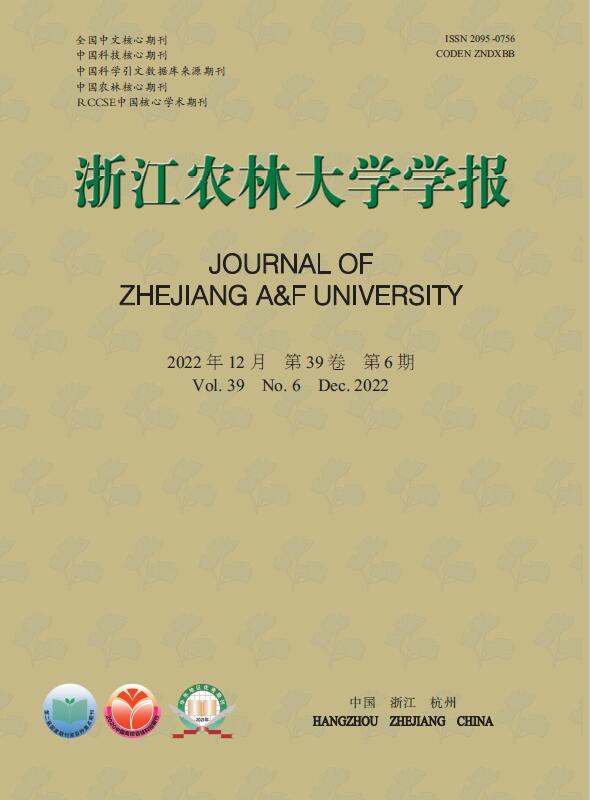








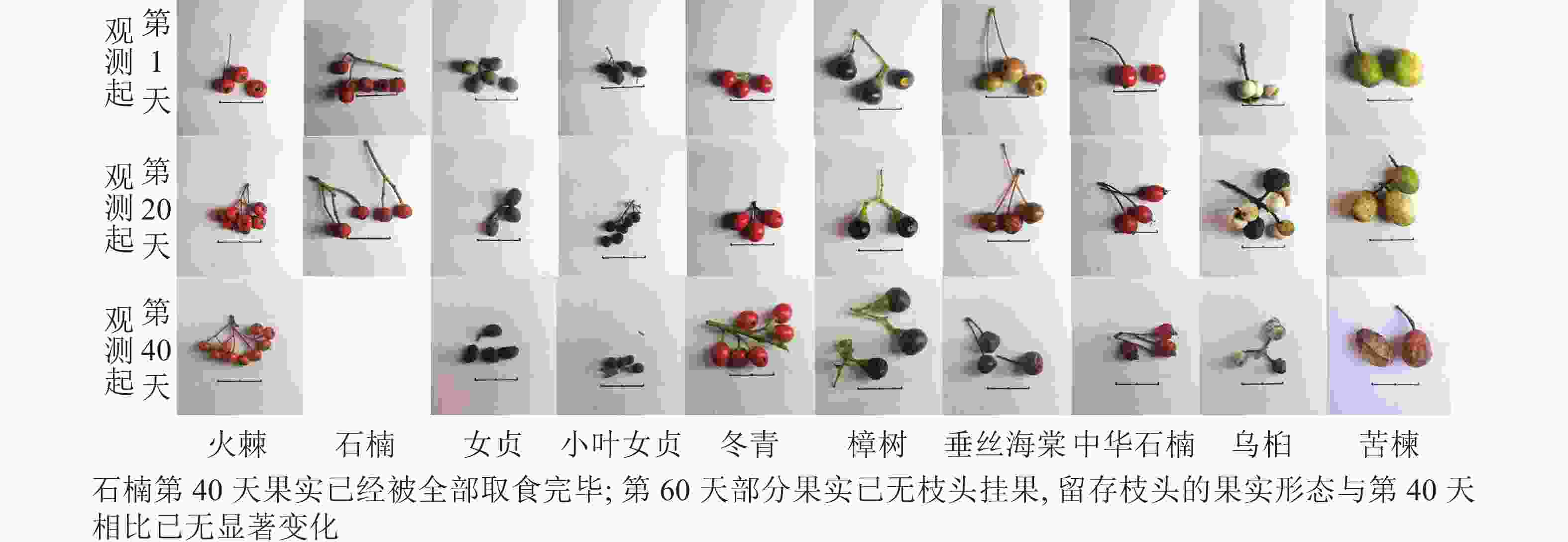
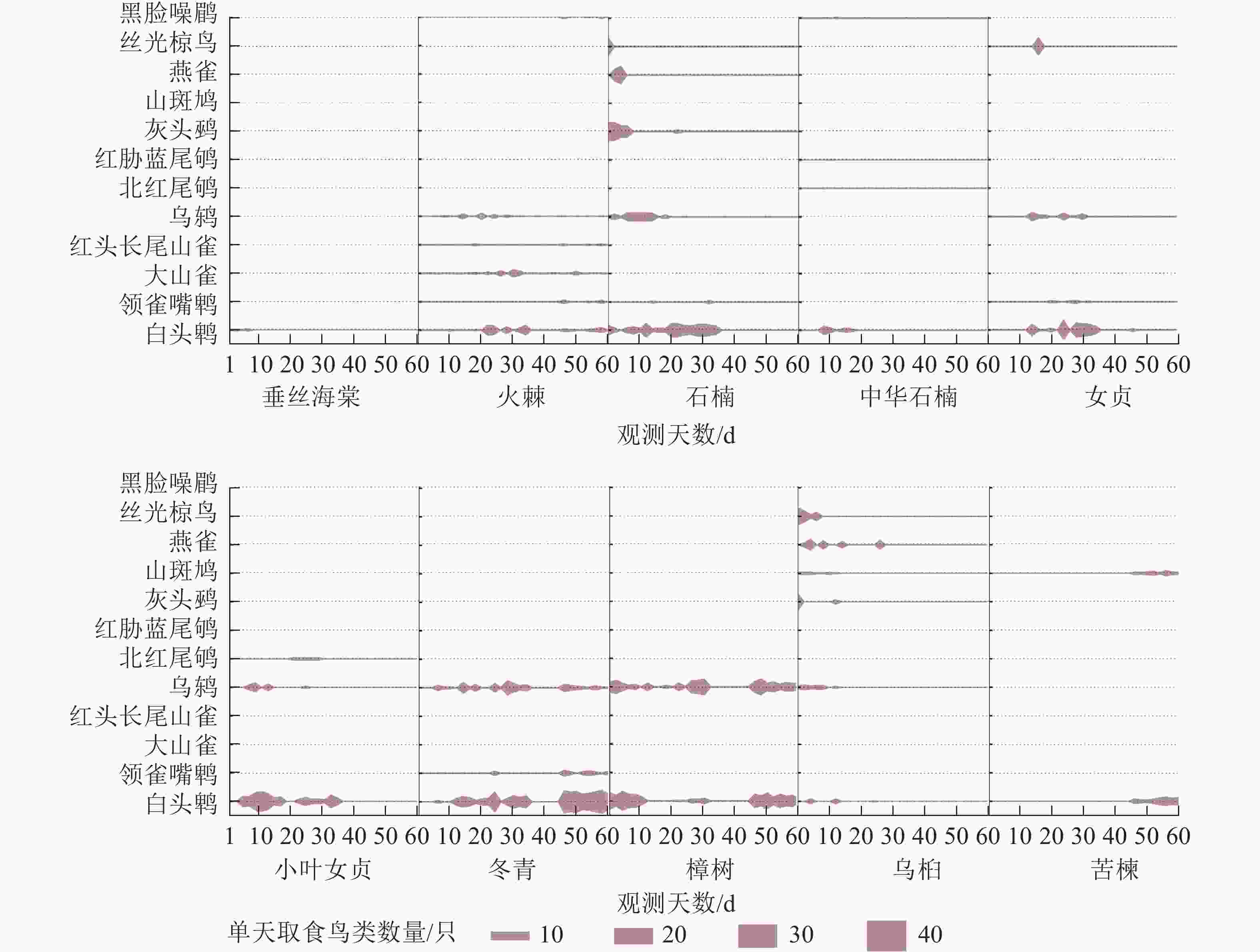


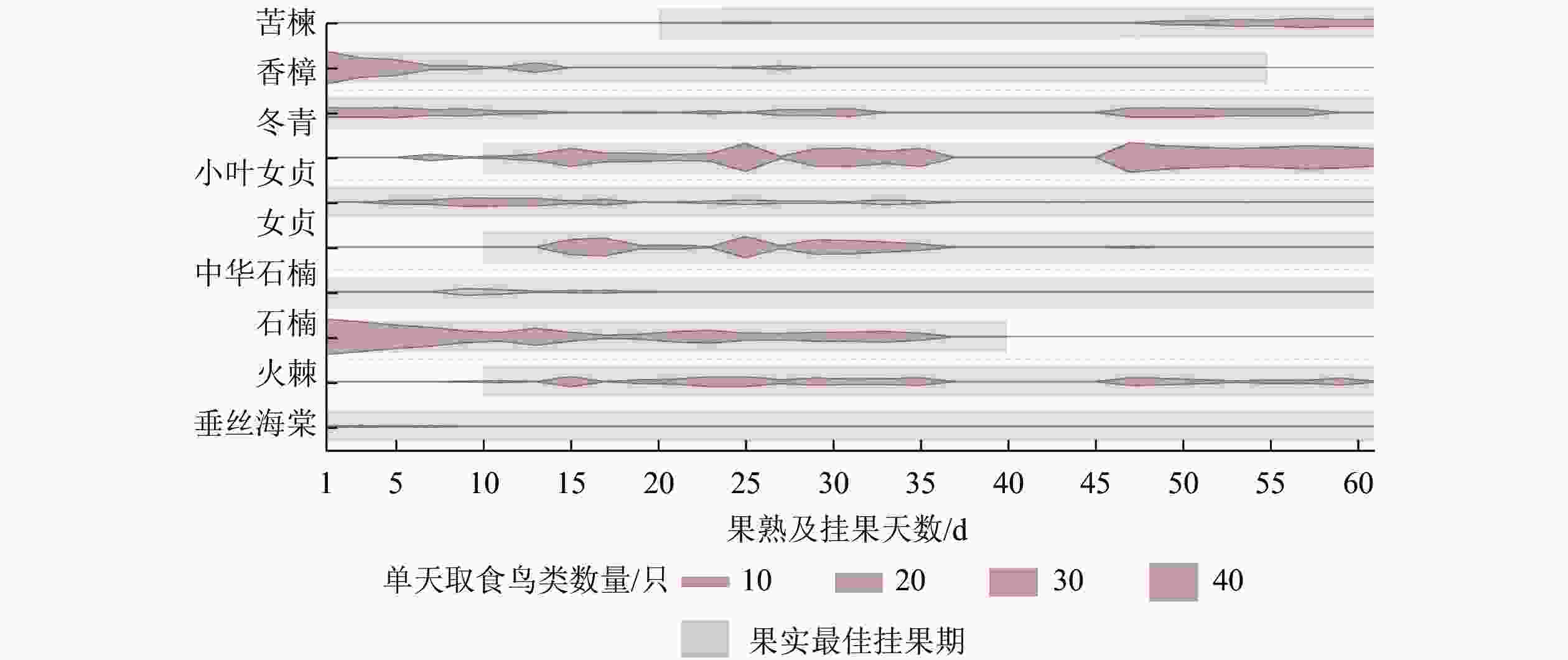

 DownLoad:
DownLoad:


